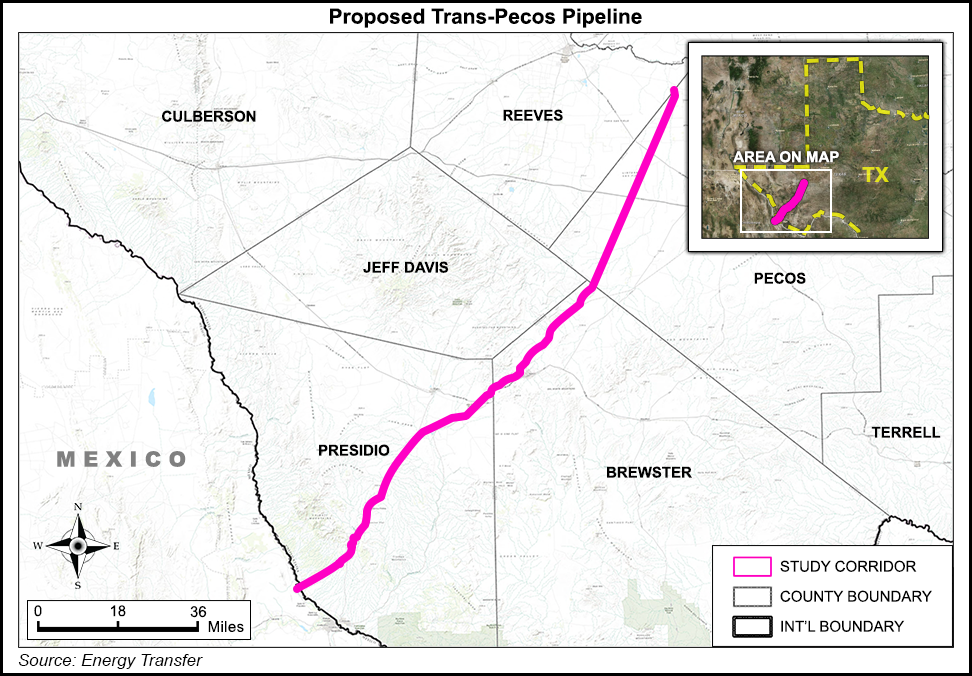Infrastructure | E&P | NGI All News Access | NGI The Weekly Gas Market Report
Trans-Pecos Pipeline Border-Crossing Facility Gets FERC Thumbs-Up
FERC has issued a presidential permit authorizing international border-crossing facilities near the city of Presidio in Presidio County, TX, and the Mexican city of Manuel Ojinaga in the state of Chihuahua for the Trans-Pecos natural gas pipeline.

The Presidio Crossing would enable the transport of gas for export and/or import between the United States and Mexico to meet the needs of the expanding electric generation and industrial markets in Mexico, Trans-Pecos said when it applied for the permit last year [CP15-500] (see Daily GPI, June 9, 2015). “The ability to import, as well as export, natural gas on the project facilities will enhance the reliability of services on both sides of the border. As such, the Presidio Crossing Project facilities will expand the market for domestically produced gas.”
The Presidio Crossing would consist of 1,093 feet of 42-inch diameter pipeline to be installed by a horizontal directional drill (HDD) from a meter facility on the north side of the Rio Grande and under the Rio Grande to the middle of the river bed at the boundary with Mexico. The pipeline portion of the HDD and other facilities to be built on the Mexico side of the boundary would be subject to the jurisdiction of the Republic of Mexico and constructed by an affiliate of Trans-Pecos.
The Trans-Pecos intrastate system would consist of 143 miles of 42-inch diameter pipeline and related facilities in Texas that would be regulated by the Railroad Commission of Texas (RRC). It would transport gas from the Waha Hub in Pecos County to the international border crossing.
The pipeline would have capacity of 1.3 Bcf/d. Trans-Pecos said it anticipates installing interconnects with other intrastate pipelines and processing plants at or near the Waha Hub and in the surrounding area and ultimately with interstate pipelines in the area. The pipeline would traverse the Texas counties of Pecos, Brewster and Presidio with potential interconnects with towns and municipalities before terminating at the border. Some area resident.
Related facilities on the Mexican side of the border are to include 907 feet of a 42-inch diameter pipeline to be built from the boundary in the middle of the Rio Grande to a point southwest in Mexico, as well as a short stub pipeline from the HDD exit point to an interconnect with the pipeline grid in Mexico. All non-jurisdictional pipeline facilities built by Trans-Pecos on the Mexico side of the boundary, and in the State of Chihuahua would be initially owned by an affiliate of Trans-Pecos.
The principal use for the natural gas transported through the border crossing would be to fuel natural gas-fired electric generation plants and supply potential industrial customers in northern Mexico, Trans-Pecos said. The pipeline is expected to transport predominantly Texas-sourced gas pursuant to the jurisdiction of the RRC, but it may also transport non-Texas-sourced gas in interstate service pursuant to Natural Gas Policy Act Section 311(a)(2) to the Presidio Crossing and to other future in-state delivery options, Trans Pecos said.
In early January, FERC staff released favorable environmental assessments (EA) of the Texas-Mexico border crossing facilities associated with both the Trans-Pecos Pipeline project and the proposed Comanche Trail Pipeline, which would also enable Texas gas to flow to Mexico to meet power generation and industrial demand (see Daily GPI, Jan. 4). Project opponents had appealed to the Commission to produce a more rigorous environmental impact statement for the entire pipeline, not just an EA for the jurisdictional border crossing (see Daily GPI, July 27, 2015).
Critics had asserted that the Trans-Pecos facilities, in conjunction with the facilities proposed for Comanche Trail near San Elizario, TX, “are part of a bigger project, and that separate review of those facilities constitutes impermissible segmentation,” FERC said in an order issued last week. But the two projects “are not connected, cumulative, or similar actions that would require consideration in a single NEPA [National Environmental Policy Act] analysis.”
Some commenters also suggested “without elaborating,” that the Presidio border crossing project might promote production and hydraulic fracturing “of shale gas generally and specifically in the Marfa Basin and the Big Bend region, which will, in turn, result in adverse environmental consequences,” FERC said. But “the fact that the easement for the intrastate pipeline is near the Barnett/Woodford shale play in the Marfa Basin by itself does not establish that the region will be opened to hydraulic fracturing or that development of those shale reserves will result from the border-crossing project.”
The Commission concluded that the pipeline would transport natural gas produced in the Permian Basin and elsewhere, would not facilitate additional production from any particular region, and, “in any event, unconventional production will likely continue regardless of whether the Presidio Border Crossing Project is approved, because multiple existing and proposed transportation alternatives are available for regional production.”
Trans-Pecos is expected to be in service by the end of first quarter 2017.
© 2024 Natural Gas Intelligence. All rights reserved.
ISSN © 2577-9877 | ISSN © 1532-1266 | ISSN © 2158-8023 |
